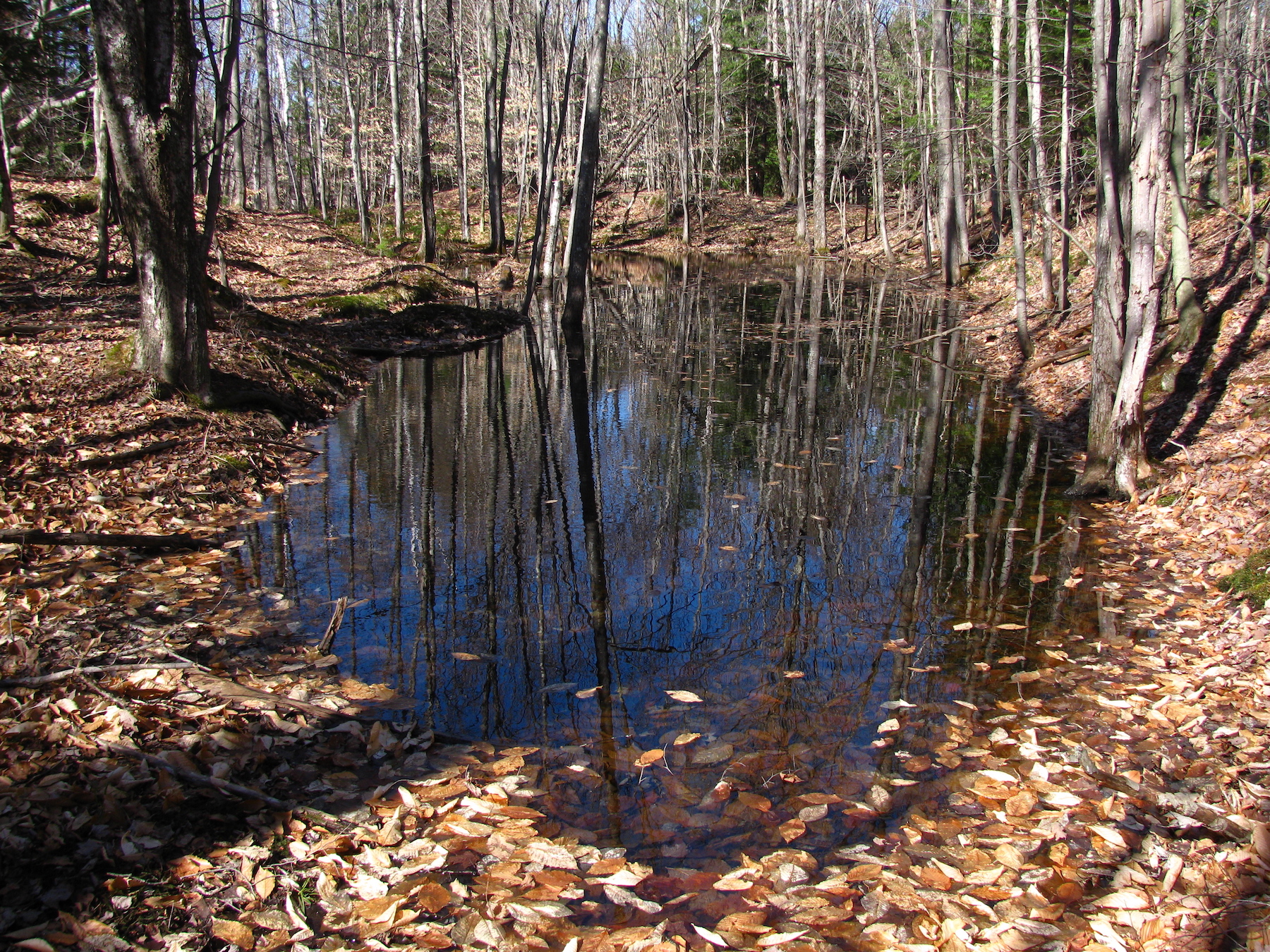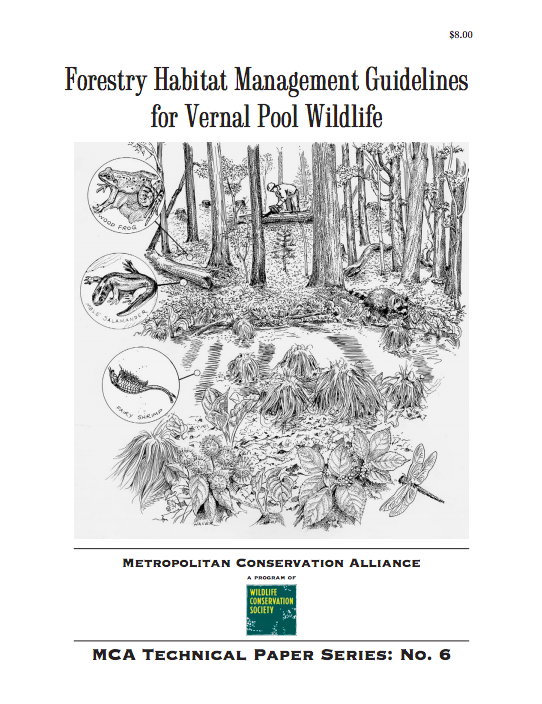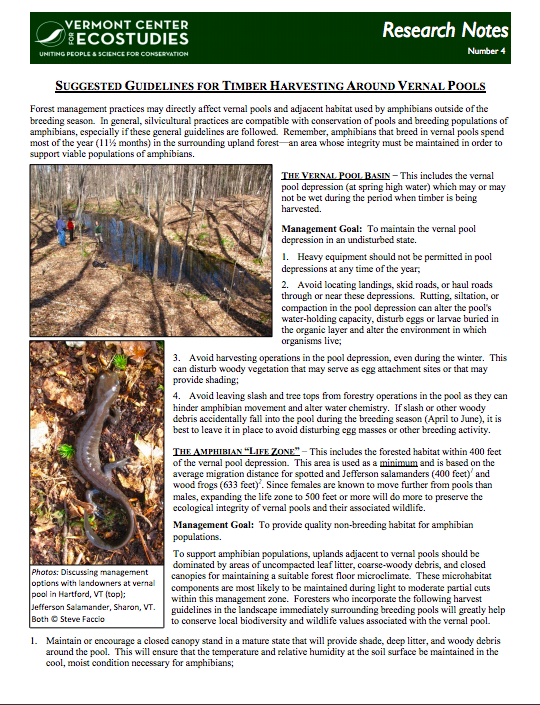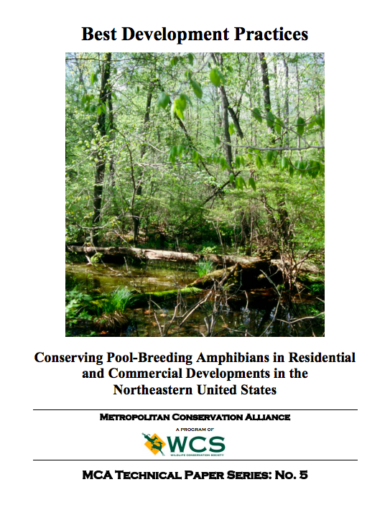Vernal pools are unique, ephemeral wetlands that provide critical habitat for many species, particularly pool-breeding amphibians and invertebrates. Given their small size, landowners and private citizens have the opportunity to make a big difference in vernal pool conservation by protecting a single pool or complex of pools on their property or in their local community. While there is much still to learn about vernal pools, there are positive steps that residents of urban and forested landscapes can take.
CONSERVING VERNAL POOLS IN FORESTED LANDSCAPES
Timber Harvesting & Vernal Pools: Suggested Guidelines
Forest management practices may directly affect vernal pools and adjacent habitat used by amphibians outside of the breeding season. In general, silvicultural practices are compatible with conservation of pools and breeding populations of amphibians, especially if these general guidelines are followed. Remember, amphibians that breed in vernal pools spend most of the year (11+ months) in the surrounding upland forest—an area whose integrity must be maintained in order to support viable populations of amphibians.
THE VERNAL POOL BASIN – This includes the vernal pool depression (at spring high water) which may or may not be wet during the period when timber is being harvested.
Management Goal: To maintain the vernal pool depression in an undisturbed state.
- Heavy equipment should not be permitted in pool depressions at any time of the year.
- Avoid locating landings, skid roads, or haul roads through or near these depressions. Rutting, siltation, or compaction in the pool depression can alter the pool’s water-holding capacity, disturb eggs or larvae buried in the organic layer and alter the environment in which organisms live;
- Avoid harvesting operations in the pool depression, even during the winter. This can disturb woody vegetation that may serve as egg attachment sites or that may provide shading;
- Avoid leaving slash and tree tops from forestry operations in the pool as they can hinder amphibian movement and alter water chemistry. If slash or other woody debris accidentally fall into the pool during the breeding season (April to June), it is best to leave it in place to avoid disturbing egg masses or other breeding activity.
THE AMPHIBIAN “LIFE ZONE” – This includes the forested habitat within 400 feet of the vernal pool depression. This area is used as a minimum and is based on the average migration distance for spotted and Jefferson salamanders (400 feet)¹ and wood frogs (633 feet)². Since females are known to move further from pools than males, expanding the life zone to 500 feet or more will do more to preserve the ecological integrity of vernal pools and their associated wildlife.
To support amphibian populations, uplands adjacent to vernal pools should be dominated by areas of uncompacted leaf litter, coarse-woody debris, and closed canopies for maintaining a suitable forest floor microclimate. These microhabitat components are most likely to be maintained during light to moderate partial cuts within this management zone. Foresters who incorporate the following harvest guidelines in the landscape immediately surrounding breeding pools will greatly help to conserve local biodiversity and wildlife values associated with the vernal pool.
Management Goal: To provide quality non-breeding habitat for amphibian populations.
- Maintain or encourage a closed canopy stand in a mature state that will provide shade, deep litter, and woody debris around the pool. This will ensure that the temperature and relative humidity at the soil surface be maintained in the cool, moist condition necessary for amphibians;
- Limit harvesting to uniformly distributed light to moderate partial cutting, leaving a minimum of 75% canopy cover within 100 feet of the pool, and 55% canopy cover between 100 and 400 feet of the pool;
- Maintain a shaded forest floor without ruts, bare soil, or sources of sedimentation/erosion. Ruts deeper than 4 inches can disrupt migration routes of salamanders. If ruts fill with water, amphibians may deposit eggs in ruts that do not hold water long enough to produce juveniles.
- Harvesting operations should occur only on frozen ground and outside of the season when juveniles and adults are active on the forest floor.
¹ Faccio, S.D. 2003. Post-breeding emigration and habitat use by Jefferson and spotted salamanders in Vermont. Journal of Herpetology 37:479-489.
² Baldwin, R.F., A.J.K. Calhoun, and P.G. deMaynadier. 2006. Conservation Planning for Amphibian Species with Complex Habitat Requirements: A Case Study Using Movements and Habitat Selection of the Wood Frog. Journal of Herpetology 40:443-454.
Download a printable copy of Suggested Guidelines for Timber Harvesting Around Vernal Pools.
CONSERVING VERNAL POOLS IN RESIDENTIAL OR COMMERCIAL AREAS
For information on conserving vernal pools in commercial or residential developments, see “Conserving Pool-Breeding Amphibians in Residential and Commercial Developments in the Northeastern United States” by Aram Calhoun of the University of Maine and Michael Klemens from the Wildlife Conservation Society.





